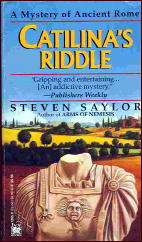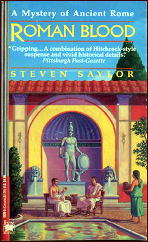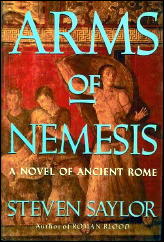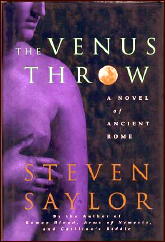Thu 19 Aug 2010
Reviewed by Barry Gardner: STEVEN SAYLOR – Catilina’s Riddle.
Posted by Steve under Bibliographies, Lists & Checklists , Characters , Reviews[9] Comments

STEVEN SAYLOR – Catilina’s Riddle. St. Martin’s Press, hardcover, October 1993. Reprint paperback: Ivy Books, August 1994. Other reprint editions exist. Roma sub Rosa #3.
I thought the first of this trilogy, Roman Blood, was the best first novel of 1991, and one of the best of that year, period. I have yet to read the second, Arms of Nemesis.
Now Gordianus the Finder (the Roman equivalent of a private eye) is Gordianus the Farmer, having inherited a farm in Etruria from an old friend. He is surrounded by that friend’s relatives, who bitterly contested the will but were defeated in the Roman courts by Gordianus’s old acquaintance and employer, Cicero.
Now Cicero is calling in his marker. He wants Goridianus to allow Catalina, one of Rome’s radical politicians, to occasionally use the farm as a refuge. Not because he’s Catalina’s friend, though; au contraire. He sees this as a way to keep track of his comings and goings. Gordianus reluctantly acquiesces, and thus is drawn into what history was to label the Catiline Conspiracy.

I remain tremendously impressed by Saylor’s skill at interweaving history and fiction and by his ability as a wordsmith. He has created a memorable character and chronicler in Gordianus, whose portrayal has deepened over the course of the series. He has acquired a larger family in the interim between the first and third books, and they too are finely drawn.
As I remarked at the end of the first book, Saylor’s love and knowledge of Roman history is evident on every page – as is his own opinion of the various historical personages.
This is less of a mystery than the first, though there is one, dealing with a series of headless corpses that appear on the farm. Mystery included or mystery aside, though, it’s an excellent novel. I can’t imagine you not liking it.
The Roma sub Rosa series —
1. Roman Blood (1990)
2. Arms of Nemesis (1992)

3. Catilina’s Riddle (1993)
4. The Venus Throw (1995)

5. A Murder On the Appian Way (1996)
6. The House of the Vestals (1997)
7. Rubicon (1999)
8. Last Seen in Massilia (2000)
9. A Mist of Prophecies (2002)
10. The Judgement of Caesar (2004)
11. A Gladiator Dies Only Once (2005)
12. The Triumph of Caesar (2008)
August 19th, 2010 at 9:23 pm
Knowing that Saylor was best known for writing gay porn I had a little trepidation when I first read one of these, but I’m happy to second everything Barry says about them.
Though I prefer Lindsey Davis Didius Falco books this is an excellent series and I like Saylor’s take on Cicero and his interesting hero.
August 19th, 2010 at 10:30 pm
1997’s THE HOUSE OF VESTALS and 2005’s A GLADIATOR DIES ONLY ONCE are collections of short stories featuring Gordianus including in the latter the fine “The Cherries of Luccullus” (one of the best historical mystery shorts I’ve read) from EQMM (May 2005), and a chronology of Gordianus cases to that point.
I also owe Saylor for introducing me in the notes for GLADIATOR to the outrageous 1935 Wallace Irwin novel THE JULIUS CAESAR MURDER CASE, a ‘hard-boiled’ mystery featuring Manny (Manilus), a reporter for the ACTA DIURNA.
August 20th, 2010 at 10:38 am
I blame it on having to take two years of Latin in high school. Ever since then I’ve had no interest in historical fiction, mystery or otherwise, that takes place in ancient Rome, none at all.
I’m glad to know, though, that two of the Roma sub Rosa books are story collections. If the stories are short enough, then maybe I can get in and out of Rome before my allergies start acting up again.
August 20th, 2010 at 11:25 am
I’ve never read any of these books but I did take 3 years of Latin in high school and remember having to read Cicero’s speeches about the Cataline Conspiracy.
August 20th, 2010 at 11:46 am
Steve
Take an allergy pill and read at least one of the Didius Falco books, or at least try to find the film made from them with Bryan Brown as Falco.
The books are fast, funny, and well plotted with Falco a sort of Roman Philip Marlowe. The historical aspect is painless even if you have nightmares left over from Latin class. You’ll quickly find yourself addicted to Falco, who has his ‘office’ over a laundry and whose mother, sisters, extended family, and noble mistress all play a continuing role in his adventures. The books are set at the end of Nero’s reign in the time of Vespasian and Domitian.
And the Gordianus shorts are a good intro to that series (Saylor also wrote a good mystery with O Henry as the sleuth). If I recall correctly I think the first set (HOUSE OF THE VESTAL VIRGINS) cover events that happen between the first two novels. “The Cherries of Luccullus”, from GLADIATOR, deals with a minor anachronism one of Saylor’s readers caught which led him to do a little research and to what I think is his best short story, and one of the best historical mystery shorts since Lillian De La Torre’s Dr. Sam stories.
August 22nd, 2010 at 10:49 am
I had three years of Latin in high school, and it was one of my favorite courses. I remember that the Scott Foresman Latin reader had stills from arguably the best of the Eddie Cantor/Busby Berkely films, “Roman Scandals,” but it was a number of years before I was actually able to see the film, with the ’40s re-release of DeMille’s “Sign of the Cross,” more immediately contributing to my love of things Roman.
A pair of books on a shelf in the back of my Latin classroom fed something that would also become a passion. The books were the two-volume account by Howard Carter of the discovery and opening of the tomb of Tutankhamen. And that passion was, of course, for archeology, which took me briefly to the University of New Mexico where I took a course on archaeology from Frank Hibben, the author of popular books on the subject. And where I realized that working in the hot sun in a desert was not something to which I wanted to devote my life.
I’ve sampled other Roman mysteries but none of them has yet seemed to me to be of the quality of Saylor’s Gordianus series.
August 22nd, 2010 at 11:16 am
Walter
You loved Latin, and I barely got through it, though I did well enough to get A’s. History was a bore also, but at least I didn’t dread it when two o’clock came around.
Now my math classes, that’s a different story!
— Steve
August 22nd, 2010 at 3:42 pm
I went on a dig/treasure hunt once looking for the lost Conquistador gold supposedly on Pack Saddle Mountain. After a few arrowheads and potshards and about twenty ridiculously large rattlesnakes (and those were just the ones we saw), mountain lion tracks, horse flies, and dive bombing ‘skeeters’, I took my horse, my burro, and found the nearest motel around San Saba. I’ll take my adventures and history in an armchair thank you.
The only high school class that didn’t bore me was English and only because the teacher looked like Mary Tyler Moore. Alas I took French and Spanish instead of Latin.
I did and do love history, but never had a decent history teacher until college. Still I did develop a love for historical fiction in that one English class reading Scott, Dumas, and Kenneth Roberts before graduating to Edison Marshall, Frank Yerby, Sabatini, and Samuel Shellabarger.
Walter
I agree about the qualities of Saylor’s Gordianus, though I do prefer Davis Falco strictly in terms of an entertaining read.
I do want to especially commend Saylor for his portrait of Cicero though. I don’t know how accurate it is when it goes beyond what we actually ‘know,’ but it feels real.
I find the Roman setting a bit easier to identify with in terms of the psychology, since in many ways the modern world is closer in psychological terms than to ancient Egypt or Europe in the Middle Ages when people really did think quite differently than we do. The Roman’s did too of course, but feel more analogous to our world for some reason — or at least good writers seem to be able to make them seem more like us without too obvious anachronisms.
The great trick of historical fiction is to show us characters we can identify with while at the same time not giving them modern views and behavior that takes them out of their own world. Saylor and Davis both pass that test with flying colors.
August 22nd, 2010 at 7:06 pm
Walter
If you happen to watch ROMAN SCANDALS again sometime look quickly for Lucille Ball as one of the blonde slave girls chained to the wall wearing nothing but long blonde hair, and notice the use of the “vessel with the pestle” routine, later one of the highlights of Danny Kaye’s THE COURT JESTER.